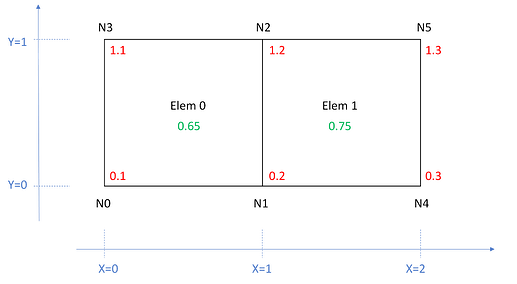Hello, I would like to display two 2D rectangular elements in Paraview, whose nodes have coordinates X and Y, nodal values ‘Nodal_Density’ and cell values ‘Pixel_Density’. Since I would need to generalize this problem to unstructured grids, I also provide a connectivity vector, which defines the ordered list of nodes belonging to the cells:
X = [0, 1, 1, 0, 2, 2]
Y = [0, 0, 1, 1, 0, 1]
connectivity = [0, 1, 2, 3, 1, 4, 5, 2]
nvalues = [0.1, 0.2, 1.2, 1.1, 0.3, 1.3] # Nodal_Density
pvalues = [0.65, 0.75] # Pixel_Density
I wrote the following Python script to translate these values into a vtk file to be used with Paraview:
import vtk
def write_legacy_vtk(X, Y, connectivity, nvalues, pvalues):
# Create VTK unstructured grid
points = vtk.vtkPoints()
for node in zip(X, Y):
points.InsertNextPoint(node[0], node[1], 0.0)
unstructured_grid = vtk.vtkUnstructuredGrid()
# Add nodes to the grid
for i in range(len(connectivity) // 4):
cell = vtk.vtkQuad()
conn = connectivity[4 * i:4 * (i + 1)]
for j in range(4):
cell.GetPointIds().SetId(j, conn[j])
unstructured_grid.InsertNextCell(cell.GetCellType(), cell.GetPointIds())
# Add nodal values to the grid
nvalues_array = vtk.vtkDoubleArray()
nvalues_array.SetNumberOfComponents(1)
nvalues_array.SetName("NODAL_DENSITY")
for nvalue in nvalues:
nvalues_array.InsertNextValue(nvalue)
unstructured_grid.GetPointData().AddArray(nvalues_array)
# Add cell values to the grid
pvalues_array = vtk.vtkDoubleArray()
pvalues_array.SetNumberOfComponents(1)
pvalues_array.SetName("PIXEL_DENSITY")
for pvalue in pvalues:
pvalues_array.InsertNextValue(pvalue)
unstructured_grid.GetCellData().AddArray(pvalues_array)
# Write VTK legacy file
writer = vtk.vtkUnstructuredGridWriter()
writer.SetFileName('output_legacy.vtk')
writer.SetInputData(unstructured_grid)
writer.SetFileTypeToASCII() # Use ASCII format
writer.Write()
#-------------------------------------------------------------------
X = [0, 1, 1, 0, 2, 2]
Y = [0, 0, 1, 1, 0, 1]
connectivity = [0, 1, 2, 3, 1, 4, 5, 2]
nvalues = [0.1, 0.2, 1.2, 1.1, 0.3, 1.3] # Nodal_Density
pvalues = [0.65, 0.75] # Pixel_Density
write_legacy_vtk(X, Y, connectivity, nvalues, pvalues)
However, the resulting file is missing most of the input data and it is not clear to me why:
# vtk DataFile Version 5.1
vtk output
ASCII
DATASET UNSTRUCTURED_GRID
POINTS 0 float
CELL_TYPES 2
9
9
CELL_DATA 2
FIELD FieldData 1
PIXEL_DENSITY 1 2 double
0.65 0.75
I am quite new to vtk library in Python and I am not sure about the commands I am using. During the execution of this script, however, I do not get any warning. Thank you very much in advance for any suggestion on how to improve the script or on how to handle the visualisation with a better approach.
